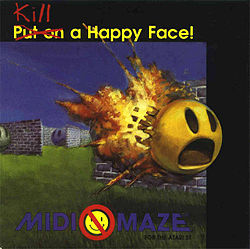- MIDI Maze
-
MIDI Maze 
Cover art of MIDI MazeDeveloper(s) Xanth Software F/X Publisher(s) Hybrid Arts, Bullet-Proof Software Platform(s) Atari ST, Atari 8-bit family, Game Boy, Game Gear, SNES Release date(s) 1987, 1991, 1992, 1993 Genre(s) first person shooter Mode(s) Multiplayer  Screenshot of MIDI Maze (Atari ST)
Screenshot of MIDI Maze (Atari ST)
MIDI Maze is an early first person shooter maze video game for the Atari ST developed by Xanth Software F/X, published by Hybrid Arts, and released around 1987. It owes a significant debt to what may be the first of its genre, Maze War. The original MIDI Maze team consisted of James Yee as the business manager, Michael Park as the graphics and distributed processing guru, and George Miller writing the AI/drone logic. It is mainly remembered now for the innovation multiplayer "deathmatch" combat by the construction of networks using the MIDI interface.
Up to 16 computers could be networked in a "MIDI Ring" by connecting one computer's MIDI-OUT port to the next computer's MIDI-IN port. Unless the computers were looped correctly, more than 4 players tended to slow down the game to a crawl and make it unstable.
Graphically the game was very simple with a humorous twist. The game area itself occupied only roughly a quarter of the screen and consisted of a first-person view of a flat-shaded Pac-Man-like maze with a crosshair in the middle. All players were shown as Pac-Man-like smiley avatars in various colors.[1][2] Bullets were represented as small balls.
The game was started by one designated "master" machine, which set rules, divided players into teams, and selected a maze. A number of mazes were supplied with the game, and additional mazes could be constructed using a simple text-editor or one of various third-party tools. The game was very popular at gatherings of Atari ST users until the end of the Atari ST era, circa 1993.
A prototype of MIDI Maze was found for the Atari 8-bit family. It is possible to connect ST and 8-bit to a network and play together.[3] A three-day all-day MIDI Maze tournament is one popular attraction at Con of the North, a gaming convention in Saint Paul, Minnesota.
Contents
MIDI-Maze II and MIDImaze Plus
MIDI-Maze II was later developed by Markus Fritze for Sigma-Soft. This game was released as shareware and contained gameplay improvements over the original.
Another improved variation, based more closely on the original Midi Maze, was Midimaze Plus from Robert and Werner Spahl featuring a compass and more detailed info on players.
Faceball 2000
A Game Boy version was developed by the original developers, Xanth Software F/X, and published in 1991 by Bulletproof Software, now Blue Planet Software, under the title Faceball 2000. James Yee, owner of Xanth, had a vision to port the 520ST application to the Game Boy. With support from Michael Park, graphics rendering techniques and communication protocol knowledge was passed on to Robert Champagne. George Miller was hired to re-write the AI-based drone logic, giving each drone a unique personality trait. It is notable for being the only Game Boy game to support 16 simultaneous players. It used a special hardware device and cables created by the game programmer, Robert Champagne. A SNES version, also programmed by Robert Champagne, was released the following year, supporting two players in split-screen mode. The SNES version substituted completely different graphics and levels from the earlier GameBoy version. A Game Gear version, which is a colorised version of the monochrome Game Boy edition, programmed by Darren Stone, was released to the Japanese market, supporting two handhelds connected by a cable. A demo version, simply titled "Faceball" was also available in Japan on a CD disc for the PC Engine. A Virtual Boy version, simply titled "Faceball" was under development, until Nintendo decided to quit manufacturing the Virtual Boy. A variety of in-game music for the SNES version of Faceball 2000 was composed by George "The Fat Man" Sanger. A multiplayer networked IBM PC version of the game was prototyped, but never released.
A version called Faceball 3000, written in Shockwave, was also available.
Reception
Faceball: 2000 was reviewed in 1994 in Dragon #201 by Sandy Petersen in the "Eye of the Monitor" column. Petersen gave the game 2 out of 5 stars.[4]
References
- ^ "25 years of Pac-Man". MeriStation. July 4, 2005. http://www.meristation.com/v3/des_articulo.php?pic=DC&id=cw42b7458f0dfc7&idj=&idp=&tipo=art&c=1&pos=7. Retrieved 2011-05-06. (Translation)
- ^ "Gaming's Most Important Evolutions". GamesRadar. October 8, 2010. p. 5. http://www.gamesradar.com/f/gamings-most-important-evolutions/a-20101008102331322035/p-5. Retrieved 2011-04-27.
- ^ "AtariProtos.com - page on the Midi Maze Atari 8-bit prototype". http://www.atariprotos.com/8bit/software/midimaze/midimaze.htm. Retrieved 2007-11-27.
- ^ Petersen, Sandy (January 1994). "Eye of the Monitor". Dragon (201): 57–62.
External links
- MIDI Maze Utilities
- MIDI Maze fan site (German)
- Faceball 2000 information page (ranked #25 of 1up.com's Essential 50)
- Faceball 2000 fan site
- Interview with Darren Stone
- Faceball 3000
- SuperMaze (Freeware Midi-Maze clone from 2005 for Windows and Linux featuring music from Amiga scene musician Chromag)
Categories:- 1987 video games
- 1991 video games
- 1992 video games
- 1993 video games
- Atari ST games
- Atari 8-bit family games
- Blue Planet Software games
- Game Boy games
- Game Gear games
- Super Nintendo Entertainment System games
- Cancelled Virtual Boy games
- Multiplayer null modem games
- First-person shooters
Wikimedia Foundation. 2010.
